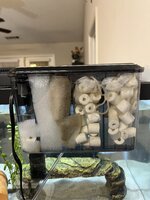not sure if I've said before but read
Axolotls - Requirements & Water Conditions in Captivity on how to make holtfreters solution and use 50% holtfreters solution with 0.1gl magnesium sulphate in the aquarium, this will help to protect your axolotl from numerous issues such as fungus as well as any nitrogen compound spikes as well as making the water more suitable for axolotls, the solution will need to be made weekly and added during a water change.
I know it seems a bit of a hassle to do but axolotls aren't freshwater animals and require salts and minerals to remain healthy.
don't forget to remove the heater and let the water cool down before putting your axolotl in the tank (tank does seem to be ready)
do water changes weekly 20% - 50%, dechlorinate water before adding, if adding bottled bacteria after water change do so 24hrs after to ensure all chlorine is removed, when testing water do so 24hrs after a water change so as not to get erroneous results.
lights can be used but ensure that your axolotl has a dark cave/hide to go into, they are mostly nocturnal.
plants can be used but some don't like slight salinity, java, duck weed, some grass types such as sagittaria.
although worms are fine try feeding a varied diet which includes some aquatic based food such as bloodworm, brine shrimp, mysis, krill, this will ensure that your axolotl is getting all the right vitamins and protein.
live fish are fine as food but stick to live bearers such as guppies, mollies and platties, don't use clean fish such as plecos, ottos, corries, as they have spikes and coarse skin which can become harmful if swallowed, any fish require 30 days quarantining.
shrimps, snails, blackworm can be used as cleaner crew.

